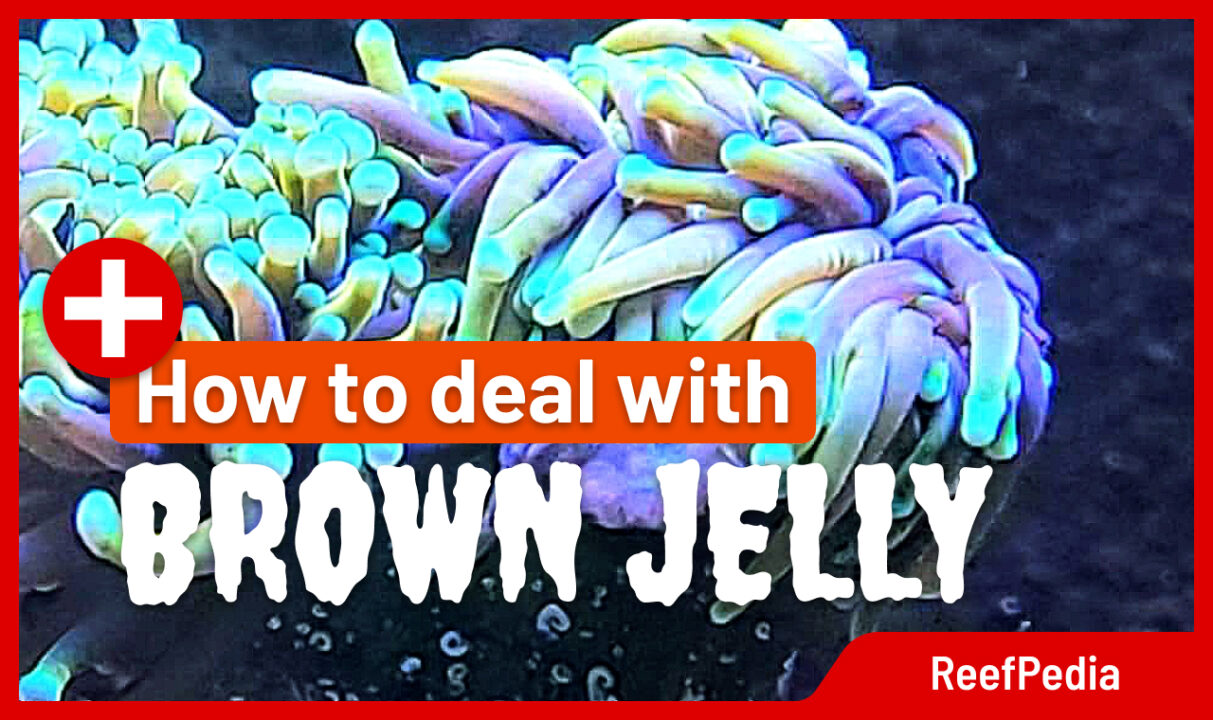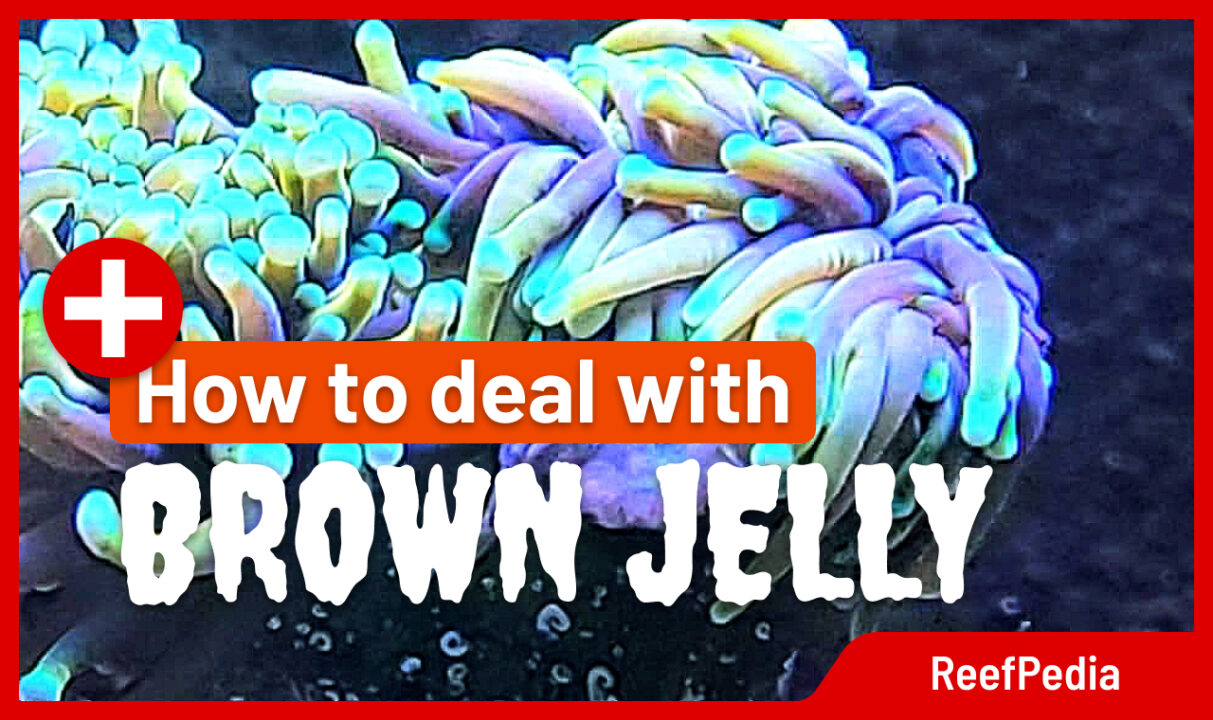Brown Jelly Disease Euphyllia: What it is and How to Treat it
Brown jelly euphyllia is a common problem that many reef tank hobbyists face. It is a contagious disease that infects Euphyllia corals, such as hammer and frogspawn corals, causing tissue to turn into a brown jelly-like substance. The exact cause of this disease is still unknown, but it is often associated with the presence of ciliates in large numbers.
Despite the lack of knowledge about the cause of brown jelly euphyllia, there are several treatments that hobbyists have been successful with. These treatments include siphoning the brown jelly and dipping the infected coral. In severe cases, the best solution is to discard the infected coral. There are also in-tank antibiotic treatments that have been experimented with, with some success.
If left untreated, brown jelly euphyllia can quickly spread and infect other corals in the tank. Therefore, it is important for reef tank hobbyists to be aware of the signs and symptoms of this disease and take immediate action to prevent its spread. In this article, we will explore the causes, symptoms, and treatments for brown jelly euphyllia to help hobbyists better understand and manage this common issue in their reef tanks.
What is Brown Jelly?
Brown Jelly is a contagious disease that commonly affects Euphyllia corals. It is named after the brownish, jelly-like substance that forms on the coral’s tissue. The cause of this disease is still unknown, but it is believed to be caused by a bacterial or protozoan infection. The disease usually starts as a small spot on the coral’s tissue and then spreads rapidly, covering the entire coral. Brown Jelly Euphyllia can cause the coral to lose its color, become slimy, and eventually die. It is important to note that Brown Jelly Euphyllia is highly contagious and can spread quickly to other corals in the tank. Therefore, it is crucial to isolate and treat the infected coral as soon as possible to prevent the disease from spreading. Some common symptoms of Brown Jelly Euphyllia include the coral’s tentacles being retracted, the coral’s tissue turning brown and slimy, and the coral losing its color. If you notice any of these symptoms, it is important to take immediate action to prevent further damage to your coral and other corals in your tank.
Causes of Brown Jelly with Euphyllia
Bacterial Infections
Brown jelly disease in Euphyllia corals is believed to be caused by bacterial infections. The exact bacteria responsible for the disease is still unknown, but studies have shown that Vibrio species and Arcobacter species may be involved. These bacteria can enter the coral through small wounds or damaged tissue, and can quickly spread throughout the colony.
Once inside the coral, the bacteria begin to break down the coral’s tissue, resulting in the formation of the brown jelly-like substance that gives the disease its name. The bacteria can also cause the coral to become weakened and more susceptible to other infections and diseases.
Environmental Factors
Environmental factors can also play a role in the development of brown jelly disease in Euphyllia corals. Poor water quality, including high levels of nitrates and phosphates, can weaken the coral and make it more susceptible to infections. High water temperatures can also stress the coral and make it more vulnerable to disease.
Additionally, overcrowding in the aquarium can lead to increased stress and competition among corals, which can make them more susceptible to infections. It is important to maintain proper water quality and provide adequate space for each coral to thrive.
In conclusion, brown jelly disease in Euphyllia corals is caused by bacterial infections and can be exacerbated by poor water quality and overcrowding in the aquarium. Hobbyists should take measures to maintain optimal water quality and provide adequate space for their corals to prevent the development of this disease.
Symptoms of Brown Jelly Euphyllia
Visual Cues
Brown jelly disease is characterized by the presence of a brown, slimy substance on the coral tissue. The brown jelly can appear as a thin film or a thick, gooey layer. This substance is actually a bacterial infection that causes tissue necrosis, or death. As the disease progresses, the brown jelly can spread rapidly to other coral colonies, making it a serious threat to reef ecosystems.
Behavioral Changes
Infected euphyllia colonies may exhibit a range of behavioral changes. For example, they may retract their tentacles or stop extending them altogether. The coral may also appear to be shrinking or receding, which is a sign of tissue loss. In some cases, the coral may completely disintegrate, leaving behind only the skeleton. It’s important to note that brown jelly disease is not always visible to the naked eye. In some cases, the bacteria may be present in the coral tissue without any visible signs of infection. For this reason, it’s important to monitor coral colonies regularly for any changes in behavior or appearance. If left untreated, brown jelly disease can quickly spread throughout a coral colony and to neighboring colonies. It can also weaken the coral’s immune system, making it more susceptible to other infections and diseases. To prevent the spread of brown jelly disease, it’s important to quarantine new coral arrivals and to maintain good water quality in the aquarium. Regular water changes, proper filtration, and adequate flow can all help to prevent the growth of harmful bacteria and maintain a healthy reef environment.
Preventing Brown Jelly Euphyllia
Tank Maintenance
To prevent brown jelly euphyllia, it is important to maintain a healthy and clean tank environment. Regular water changes, proper filtration, and adequate lighting can help keep corals healthy and reduce the risk of disease. It is also important to monitor water parameters such as temperature, salinity, and pH, as fluctuations can stress corals and make them more susceptible to disease. In addition to general tank maintenance, it is important to pay attention to the placement of euphyllia corals in the tank. Euphyllia corals should be placed in areas with moderate water flow and adequate lighting. High flow can damage the delicate tissue of the coral, while low flow can lead to the buildup of detritus and other debris, which can contribute to the growth of harmful bacteria.
Quarantine Procedures
Another important step in preventing brown jelly euphyllia is to quarantine new corals before introducing them to the main tank. This can help prevent the introduction of new pathogens and parasites that can harm existing corals. During the quarantine period, it is important to monitor the health of the new coral and treat any signs of disease before introducing it to the main tank. When selecting new corals, it is also important to choose healthy specimens from reputable sources. Sick or stressed corals are more likely to develop brown jelly and other diseases, so it is important to choose specimens that are free from signs of disease or stress. By following these simple steps, aquarists can help prevent brown jelly euphyllia and keep their coral reefs healthy and thriving.
Treating Brown Jelly Euphyllia
Natural Remedies
When it comes to treating brown jelly euphyllia, there are a few natural remedies that can be effective. One option is to physically remove the brown jelly with a pipette or turkey baster around the infected areas. This must be done carefully to avoid smothering other corals. We suggest turning off all of your flow when doing this in order to minimize the risk fo spread.
Another option is to dip the coral in a solution of iodine or pyodine (10% iodine) and potassium chloride (Kcl). Another natural remedy is to introduce enough bacteria and probiotics to ensure a healthy bacteria colony is present. This can be accomplished by dosing the tank with a product like Microbacter7 or Vibrant. Additionally, ensuring UV is installed can help keep the tank clean and prevent the spread of disease.
Medications
If natural remedies are not effective, medications may be necessary. One option is to use Chemiclean, which is a form of erythromycin. Another option is E.M. Erythromycin (API), which can be effective against brown jelly disease. API Fin and Body Cure (Doxycycline hyclate) is another medication that can be used to treat brown jelly euphyllia. It is important to note that medications should be used with caution and only as a last resort. Overuse of medications can harm the coral and the overall health of the tank. It is also important to follow the instructions carefully and monitor the coral closely during treatment.
Conclusion
Brown jelly disease is a contagious infection that affects Euphyllia corals. The cause of the infection is still unknown, but it is believed to be caused by bacterial or ciliate pathogens. The disease can be identified by the presence of brown, slimy material on the coral’s tissue, which can eventually lead to the coral’s death if left untreated.
There are several treatments that hobbyists have been successful with, including siphoning the brown jelly and dipping the infected coral in a solution of iodine or antibiotics. However, it is important to note that these treatments are not guaranteed to work and can potentially harm the coral if not done correctly.
Preventing brown jelly disease from occurring in the first place is the best course of action. Maintaining proper water quality, avoiding overcrowding in the aquarium, and providing adequate lighting and flow can all help to prevent the spread of the disease. Additionally, quarantining new corals before introducing them to the main tank can help to prevent the spread of infection. source
Brown Jelly Disease: Causes & Treatment
Sometimes things go smoothly in your aquarium, and then “bam” just like that, you have a brown jelly disease outbreak. The victims of this nasty disease are usually corals from the Euphyllia group.
Euphyllia Corals include some of our favorite LPS corals: Torches, Frogspawns, and Hammer Corals. They are without a doubt one of the most beautiful corals to add to reef aquariums, and their popularity means they will continue to dominate hobbyist’s tanks around the world. Their popularity comes from their fleshy polyps, vibrant color morphs, rapid growth, and hardiness.
Unfortunately, keeping Euphyllia Corals does come with one warning, and that is brown jelly disease.
What Causes Brown Jelly Disease?
Brown jelly disease is an issue that many hobbyists who have Euphyllia are likely to run into. Like most coral diseases, the cause of pathogen infections like brown jelly disease is still unknown. However, microscopic examination of coral tissues that were infected by brown jelly had numerous ciliates called Helicostoma nonatum.
Even though we know there are ciliates present in the brown jelly mucus, scientists have still not determined what role they play in the disease. Because there are so many microbes present within the slime, it is hard to say which ciliate causes the infection. It is also still unclear if the ciliates are primary pathogens or secondary opportunists in brown jelly infections. But, there is increasing evidence that motile ciliates do play a role in coral diseases and opportunistic ciliates are not helping your Euphyllia survive the disease.
When it comes to causes of diseases on a hobbyist level, we can only come up with assumptions based on experience. Many hobbyists have found that poor water conditions, overfeeding, and damaged tissues can contribute to brown jelly infections, however, this is only “hear-say” and not scientifically proven yet.
What Does Brown Jelly Disease Look Like & How To Spot It Early
If your coral is covered in a brown, gelatinous mass (like a slime or jelly-like “goo” substance) that is covering your coral’s flesh, it is likely you have a brown jelly outbreak.
The brown jelly is associated with rapid tissue loss (RTS), which very quickly spreads to neighboring corals, regardless of the species. Because of the high contagion rates of RTS, once a coral is infected, you must act fast otherwise it will quickly deteriorate and die.
If you take a close look at your infected coral, you will notice this brown jelly-like substance floating on the surface of your coral, moving around as your coral’s polyps sway with the water flow. The brown substance is also sometimes associated with a rotten smell once the coral has been removed from the aquarium.
Spotting brown jelly disease early will determine if treatment is possible. As an aquarium hobbyist, it is important to check individual corals on a daily basis, so you can catch infections such as brown jelly before it overrules your aquarium.
Treatment For Brown Jelly Disease
Depending on how bad the brown jelly infection is, will determine which treatment is best. Many hobbyists have had success with different treatment methods, however, do not be too hard on yourself if you try them yourselves, and they do not work. Brown jelly disease is a very difficult infection to treat because we do not know the cause.
Many reef hobbyists have tried treating infected Euphyllia Corals affected by brown jelly disease outbreaks with different coral dips, but many have not succeeded and would agree that the best option is to frag off the infected area and throw it away. This can be a very hard decision to make, and trust me, I feel your pain, but a coral that is “too far gone” is better thrown away, than spreading the infection to all your other corals.
Siphon Removal
You can try to physically remove the brown jelly with a pipette or turkey baster around the infected areas (head). This must be done very carefully, so you do not smother your other corals, therefore it is recommended to remove your infected coral and treat it in a separate tank or container.
If you must treat your coral inside an aquarium and cannot remove the coral, turn off all water flow. Take a pipette (or turkey baster) and siphon off the dead tissue and “goo” covering your infected coral.
It is highly recommended, however, that you treat your coral outside the main aquarium. When removing an infected coral head, turn off any water flow, so the jelly is not blasted around the aquarium. When removing your coral, also make sure you wear gloves as some corals in your aquarium may contain toxins like palytoxin which is extremely harmful if it gets into your bloodstream.
It is also recommended to frag heavily infected sections to reduce the spread and then continue treatment with a coral dip.
Coral Dips & Antibiotics
Dipping a coral infected with brown jelly disease will hopefully eliminate the infection.
There are different kinds of coral dips that you can try, but the best to treat fungal, bacterial, and microbial infections are iodine-based dips such as Seachem’s Reef Dip, or potassium-salt-based coral conditioners like Polyp Lab’s Reef Primer. (and to rid of other parasites unlrelated to Brown Jelly Disease many reefers use Blue Ocean Coral RX
Coral Dip: Seachem’s Reef Dip
This Reef Dip must never be added directly into your reef aquarium, so set up a separate container to dip your infected coral.
- Per 4 L of aquarium water, add 1-2 caps (5-10 ml) of Reef Dip and mix thoroughly.
- Dip your infected coral for 15-30 minutes.
- Remove your coral from the dip and place it back into the aquarium.
Coral Dip: Polyp Lab’s Reef Primer
Reef Primer must never be added directly into your reef aquarium, so set up a separate container to dip your infected coral.
- Per 4 L of aquarium water, add 8 caps (or 45 g) of Reef Primer and mix thoroughly.
- Dip your infected coral for a maximum of 5 minutes.
- Remove your coral from the dip and place it back into the aquarium.
Antibiotics
Just like how you would use antibiotics to fight infections, antibiotics can also be used to treat brown jelly disease, and hopefully, give your coral a fighting chance to survive.
Many hobbyists have been successful in using Ciprofloxacin because it is still very effective in low doses, minimizing damage from dipping. It is recommended to use 0.125 mg/L of Ciprofloxacin by dissolving a 500 mg tablet in 50 ml of reverse osmosis deionized (RODI) water.
Per 260 L of aquarium water, add 3.3 ml of the mixed antibiotic solution. Repeat this for the next 2-3 days and check the coral’s condition.
Conclusion
Brown jelly is a contagious disease that commonly infects Euphyllia Corals. The cause of this infection is still unknown, however, there are a few treatments that hobbyists have been successful with, which include siphoning the brown jelly and dipping the infected coral.
In severe cases, the best solution is to discard the infected coral. Removing a coral that is infected with brown jelly disease will save the rest of your corals in the aquarium.
We wish you all the best in saving your coral from brown jelly disease. If you have had any success with other methods of brown jelly treatment, we would love to hear all about it – leave a reply below!
General information
Brown Jelly Disease is one of the biggest threats to corals, especially species of the Euphyllia genus. The disease gets its name from the characteristic brown, jelly-like coating that covers corals, often leading to their rapid death. Understanding the causes, symptoms, and effective treatment methods is crucial for protecting the health of these delicate saltwater organisms.
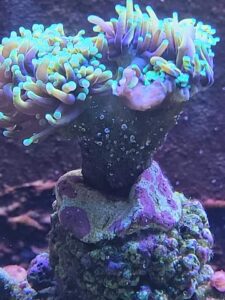
What causes Brown Jelly?
Despite extensive research, the exact causes of Brown Jelly Disease are not clearly defined. Although the precise cause is not fully known, it is believed that various pathogens, including bacteria, are responsible for its occurrence. Different theories suggest that ciliates may also create favorable conditions for pathogen development or act as secondary factors in the disease progression. Brown Jelly often appears on corals that have been physically damaged, indicating that the weakening of their natural protective barrier promotes infection.
Other studies suggest that the microorganisms responsible for the disease may be present in the aquarium due to poor sanitation or transfer from another infected tank. Brown Jelly can also develop as a result of coral stress caused by improper water parameters, such as unstable pH, temperature, or excessive nitrogen compounds.
Diagnosing the Disease
Symptoms of Brown Jelly are usually easy to spot. A brown, jelly-like substance appears on the corals, often emitting an unpleasant smell. An infected coral may also show signs of weakening, such as not opening its polyps, fading colors, or rotting. Early detection is crucial as it allows for prompt action to limit the spread of the infection to other corals.
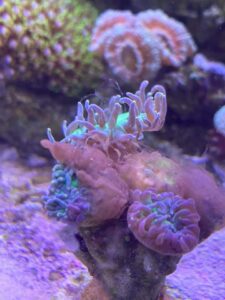
Preventive Measures
Preventing diseases in a reef aquarium is always better than treating them. Regularly testing water parameters, maintaining stable environmental conditions, and isolating new corals before introducing them to the main tank are fundamental steps that can significantly reduce the risk of Brown Jelly Disease. It’s also important to avoid excessive relocation and handling of corals, which can lead to damage, stress, and increased susceptibility to infections.
The most important step upon detecting the disease is isolating the infected coral. It’s recommended to move it to a quarantine tank to prevent the disease from spreading. During this time, it’s crucial to turn off all circulation devices in the main aquarium to limit the spread of pathogens.
Treatment Methods
Antibiotic Therapy
Treating Brown Jelly disease with antibiotics such as Ciprofloxacin requires special attention to dosage and the duration of therapy. Here’s how to properly use Ciprofloxacin for treating this disease:
- Preparation of solution: Dissolve 500 mg of Ciprofloxacin in 50 ml of RO/DI water to obtain a solution with a concentration of 10 mg/ml. Store the solution in a dark container in the refrigerator to prevent degradation of the medication.
- Dosage: Calculate the dose based on the amount of water in your aquarium. For example, for a tank with a capacity of 38 liters, use 0.475 ml of the prepared solution. This dosage provides the required drug concentration of 0.125 mg/l.
- Calculating the dose for the aquarium
- Calculate the total required amount of Ciprofloxacin: Multiply the capacity of the aquarium by the recommended concentration of 0.125 mg per liter. 38 liters (10 gal) ×0.125 mg/l=4.75 mg
- Convert to solution volume: You now need to divide the amount of Ciprofloxacin in mg by the solution concentration to get the volume in milliliters. 4.75 mg÷10 mg/ml=0.475 mlSo, you need 0.475 ml of your Ciprofloxacin solution as the dose to achieve the desired concentration in your 38-liter (10 gal) aquarium.
- Calculating the dose for the aquarium
- Application: Add the appropriate amount of solution directly to the aquarium, preferably in the evening, to minimize impact on sensitive organisms.
- Duration of therapy: Continue adding the solution every two days for a period of 7 to 10 days, monitoring the condition of the corals and water parameters such as pH, ammonia, nitrites, nitrates, and carbonate hardness (kH).
- Observation: Regularly observe the corals’ response to the treatment. It is important to monitor the health of the corals and the stability of the water parameters.
- End of treatment: After completing the treatment, perform a partial water change and turn the protein skimmer and carbon filters back on to remove any antibiotic residues from the water.
- Additional precautions: Always follow the dosing recommendations and do not exceed the recommended dose. If there is no improvement or if adverse reactions occur, consult with an experienced aquarist or a specialist in coral diseases.
There are many methods and dosages related to antibiotic therapy, but I prefer this particular variant. I have discussed this topic with many aquarists who have confirmed the universality and effectiveness of this method.
|
Dipping
Dipping is a popular treatment method involving briefly immersing corals in a therapeutic solution. There are specialized products available for coral disease management, such as those based on iodine or potassium salts, which can be used for regular coral dips to eliminate pathogens. It’s important to strictly follow the manufacturer’s instructions to avoid harming the corals.
One commonly used solution is povidone-iodine, which is effective against many pathogens. The dipping solution is prepared by mixing 10 ml of iodine per 1 liter of clean seawater. Corals should be dipped for about 10-15 minutes. This procedure can be repeated every few days while continuously monitoring the coral’s condition.
Additional Treatment Strategies
Amputation
In advanced stages of the disease, more invasive methods like amputation of infected parts of the coral can be considered. Although a difficult decision, sometimes it’s necessary to remove significant portions of the coral to prevent the disease from spreading to healthy tissues and other corals in the tank. Amputation should involve removing the infected tissue along with a small margin of healthy tissue to ensure that all infected tissue is completely removed.
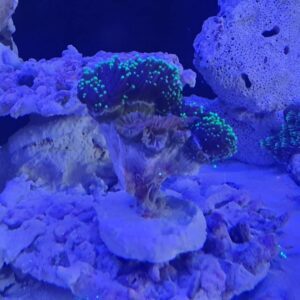
Improving Aquarium Conditions
Changing aquarium conditions, such as improving water circulation or adjusting mineral levels, can also contribute to improving the health of corals. Stable conditions are crucial for maintaining coral resilience against various diseases.
Summary
Brown Jelly is a serious disease that can cause significant harm to a coral reef, especially to euphyllia corals. However, with proper knowledge and methods, we can effectively prevent its spread and negative effects. Regularly monitoring the aquarium’s condition, using proper quarantine procedures, accurately applying medications and dips, and managing the coral’s living environment are crucial for maintaining the health and beauty of the coral reef, including the stunning euphyllia corals.
Other Reefers have done the following to treat Brown Jelly Disease
HI reefers.
Hope all well. Off late i had been losing my torch coral heads one after another. Despite fragging the frag head could not survive the slow decay and finally Brown jelly was Visible just before its last breath. I searched various Forum and also read how Antibiotics can help in killing Arcobacter responsible for BJD. Here is What I decided to undertake before loosing my first ever coral to disease.
Preparations
Step-1. Ensuring Water Parameters are OK and Stable.
Step 2. Ensuring No Other Toxicity is Present in reef to avoid likelihood of other variables in play.
Step-3. Dosing Enough bacteria and probiotics to ensure some healthy bacteria colony is present.
Step-4. Avoid Direct feeding Roids etc to Torch
Step-5. Ensure UV is Installed
Experiment
Step-1. Arrange Kcl (Potassium Chloride ) and Iodine or Pyodine (10% Iodine) a Normal Wound Scrubber.
Take out 500ml in a can and put orch Coral in it. Add 3-5 Vials of Kcl and 5ml Pyodine over Torcha nd Stir.
Leave it for 15-30 Mins in Reef water Floating so Temp remains Stable.
Very Important to Strongly Rinse Torch Coral after few Minutes to blew Away and jelly Type White Substance emerging out of Torch.
SHift Torch to Another 500 ml Clean tank Water and Put Revive in it.
After 10-15 mins, Rinse and Put back the Torch.
Repeat This process daily for 3 Days. and Then let Torch Rest for 3-5 days.
Step-2. Antibiotics Treatment
Take a 500mg Ciprofloxacin and crush it and mix in 50 ml RODI water. Refrigerate it after good mixing.
Keep a capsule of Amoxillin Antibiotic
Vibrant being Algaecide
Revive ex TLF to heal if needed.
Take out Torch Coral in a 500 ml tank water and put 5ml of Cipro Solution and Rinse
Add a Pinch of Amoxillin Capsule and Mix in same water.
Put Few Drops of Vibrant and place it in reef floating to maintain temperature.
After 40-45 mins, Take out Torch and put it in other 500ml clean tank water and add revivce for 15 Mins.
Rinse and put Torch Coral back in Aquarium
Repeat 2nd and 3rd bath same way daily for next 2 days.
Give Rest of 2-3 days and Observe.
Give 4th and 5th bath with 2 days gap in between each bath.
Let Torch Rest.
Video Explanation and After Results: At my YouTube Channel” MQReef ”

